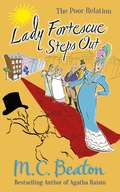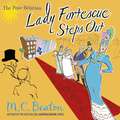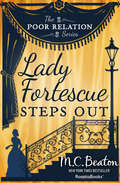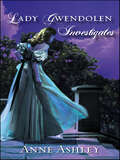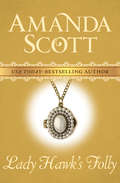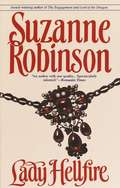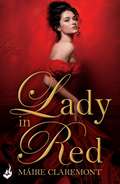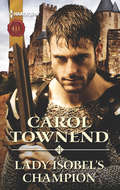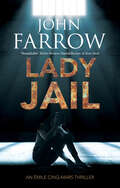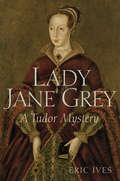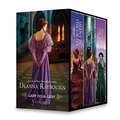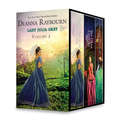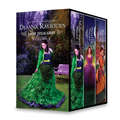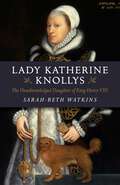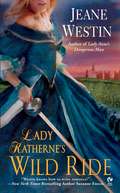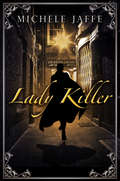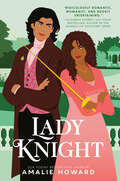- Table View
- List View
Lady Fortescue Steps Out (The Poor Relation)
by M.C. BeatonThe first book in M.C. Beaton's charming Poor Relation series. What do you do if you are of noble stock, but impoverished, and living in London with a certain style to maintain? One has to work... but One's relatives will be appalled when One turns One's hand to trade - and opens a hotel, The Poor Relation, offering employment to others of the same social standing and in the same awkward situation. This is precisely what Mrs Fortescue decides upon and, together with friend Colonel Sandhurst, transforms her decrepit Bond Street home into a posh hotel, offering guests the pleasure of being waited upon by the nobility. So with the help of other down-and-out aristocrats they do just that - and London's newest, and most fashionable! - hotel is born... much to the dismay of the Duke of Rowcester, Lady Fortescue's nephew, who is convinced his aunt's foray into trade will denigrate the illustrious family name!'Romance fans are in for a treat' - Booklist'[M. C. Beaton] is the best of the Regency writers' - Kirkus Reviews
Lady Fortescue Steps Out (The Poor Relation)
by M.C. BeatonThe first book in M.C. Beaton's charming Poor Relation series. What do you do if you are of noble stock, but impoverished, and living in London with a certain style to maintain? One has to work... but One's relatives will be appalled when One turns One's hand to trade - and opens a hotel, The Poor Relation, offering employment to others of the same social standing and in the same awkward situation. This is precisely what Mrs Fortescue decides upon and, together with friend Colonel Sandhurst, transforms her decrepit Bond Street home into a posh hotel, offering guests the pleasure of being waited upon by the nobility. So with the help of other down-and-out aristocrats they do just that - and London's newest, and most fashionable! - hotel is born... much to the dismay of the Duke of Rowcester, Lady Fortescue's nephew, who is convinced his aunt's foray into trade will denigrate the illustrious family name!'Romance fans are in for a treat' - Booklist'[M. C. Beaton] is the best of the Regency writers' - Kirkus Reviews
Lady Fortescue Steps Out: A Novel Of Regency England - Being The First Volume Of The Poor Relation (The Poor Relation Series #1)
by M. C. BeatonAn impoverished widow opens a hotel serving the society she has fallen from in this regency romance featuring characters who &“leap off the pages&” (Publishers Weekly). After her husband&’s death, Lady Fortescue knows she must work, even though the thought will appal her society relatives. So she decides to transform her once-grand Bond Street home into a hotel, the Poor Relation, offering society guests the pleasure of being waited upon by nobility. With the help of other down-and-out aristocrats, London&’s newest, most fashionable hotel is born. And it is the perfect venue for Lady Fortescue to play with the love lives of her guests and staff, starting with her nephew, the dashing Duke of Rowcester. Lady Fortescue has it on good authority that the duke once shared a dance with darling Harriet James, the hotel cook. When the duke comes to London, Lady Fortescue orchestrates a reunion that is sure to scandalize the ton . . . New York Times bestseller M.C. Beaton, the pen name for regency author Marian Chesney, &“expertly sets the scene, recapturing the bawdiness and color of a long-ago time. . . . Hilarious and tragic; larceny, attempted murder, a satisfactory love affair and unlikely alliances make the hotel the liveliest spot in London&” (Publishers Weekly). &“A charming and humorous Regency.&” —Library Journal &“A solid cast of eccentrics.&” —Booklist
Lady Gone Bad (Gone Bad #1)
by Sabine StarrA Woman's SecretsThe saloon singer known as Lady Gone Bad is the most drop-dead gorgeous outlaw the West has ever seen. Lady has never met a cowboy she couldn't entice, or a lawman she couldn't outrun. But when Lady tangles with a sexy U.S. Marshall, she's tempted to stick around long enough to watch him lay down the law--in her bed. A Man's DesiresU. S. Marshall Rafe Morgan wants to lock up Lady Gone Bad for good--and he won't let his attraction to her slow him down. But when his attempt to bring Lady to justice goes awry, Rafe is nearly hanged--and by dawn, his face is plastered next to hers on every "Wanted" poster in Texas. A Passion UnleashedNow on the run together, Rafe and Lady find themselves in very close quarters--and even more compromising positions. As Lady surrenders to Rafe's touch, she slowly begins to reveal all her secrets--including her real name. Maybe Lady Gone Bad isn't beyond redemption after all. Either way, Rafe is in for one wild ride. . ."An exciting read!" --New York Times bestselling author Bobbi Smith
Lady Gwendolen Investigates
by Anne AshleyElegant yet feisty, well traveled yet innocent to the world, beautiful yet modest-prying into others' lives isn't for Lady Gwendolen Warrender. Until murder and mayhem come to Marsden Wood!And every good sleuth needs a partner. Who better than dashing master of the manor Jocelyn Northbridge? With his touch of arrogance, intelligent eyes and brooding chivalry, she knows he'll make the perfect accomplice. But soon the renowned bachelor has more than solving murder in mind.It seems Gwendolen may have uncovered her very own marriage proposal!
Lady Hawk's Folly
by Amanda ScottWhen her husband returns from war, the Marchioness of Hawkstone battles for her independenceLess than two weeks after their wedding, Gavin Colporter, Marquess of Hawkstone, left his lovely wife Mollie at home and went off to war with Lord Wellington. Four years later, Mollie has become accustomed to running the estate and doing as she pleases. It&’s quite a shock when Hawkstone returns and immediately begins to assume his rights and responsibilities as lord of the manor. Can she learn to submit to his authority? What will he say when he hears certain scandalous rumors about her activities in his absence? And can these two near-strangers actually learn to live together as husband and wife?
Lady Helena's Secret Husband
by Elizabeth BeaconAn intense second chance storyHer secret husband…Is back from the dead! When Lady Helena Snowe eloped with Captain William Harborough six years ago, they had one glorious week together before he went to war—only to die in battle. Yet, the man in front of her now is very much alive! The darkness behind Will&’s eyes makes Helena wary of letting him back into her life. With Will&’s enemies threatening their chance of a fresh start, can their marriage ever be reclaimed? From Harlequin Historical: Your romantic escape to the past.
Lady Hellfire (Ladies #2)
by Suzanne RobinsonAfter she braved the perils of the American frontier, Kate felt there wasn't a man alive whom she couldn't handle. But when she found herself faced with an arrogant English lord--who said he already had too many women in his life--Kate vowed she would not be just another one.
Lady In Red: Mad Passions Book 2 (Mad Passions)
by Maire ClaremontA richly romantic and enthralling novel of beauty, passion and scandalous secrets from the acclaimed author of The Dark Lady. Perfect for fans of Grace Burrowes, Tessa Dare, Elizabeth Hoyt and Sarah MacLean.Lady Mary Darrel should be the envy of London. Instead, all society believes her dead. For Mary holds a secret so dangerous, her father chose to keep her locked away...and have a grave made for her near her mother's. Driven to the edge of desperation, Mary manages to escape the asylum, only to find that her fate yet again rests in the hands of a man...Edward Barrons, Duke of Fairleigh, longs for some way to escape the torment of his father's crimes. In Mary's warrior spirit and haunted gaze - which so mirrors his own - he finally sees his path to redemption. He will stop at nothing to keep her safe, even as she seeks revenge. But will the passion they discover in each other be enough to save them from their demons?For more deliciously dark Victorian romance, try all the titles in the Mad Passions series: The Dark Lady, Lady In Red, A Lady Undone and The Dark Affair, and check out Maire's alter-ego Eva Devon for sexy and laugh-out-loud funny Regencies.
Lady Isabella's Scandalous Marriage
by Jennifer AshleyLady Isabella Scranton scandalized London by leaving her husband, notorious artist Lord Mac Mackenzie, after only three turbulent years of marriage. But Mac has a few tricks to get the Lady back in his life, and more importantly, back into his bed.Read a deleted scene from Lady Isabella's Scandalous Marriage.
Lady Isobel's Champion
by Carol TownendHis Lady in WaitingIn her long years at the convent, waiting for her betrothed, Lady Isobel de Turenne has built the Comte d'Aveyron into a fantasy-a man who will rescue, protect and love her....But when the comte finally returns to claim his bride, Isobel finds instead a man of contradictions-one who masks dark secrets with desire.Wary of a man's touch but desperate to grasp her new freedom, Isobel must decide if it's solely duty forcing the comte to marry or whether he is truly her longed-for champion.
Lady Jail (The Émile Cinq-Mars Thrillers)
by John FarrowWelcome to Lady Jail: a nest of killers, and not all of them are getting out alive . . . Quebec, 1994. Fraud artist Abigail, the newest arrival at the Joliette Institution for Women, is struggling to adjust to the prison’s communal quarters. Her fellow inmates only give out the bare bones of their crimes, and it’s quite the roll call. Doi took a hatchet to her own daughter. Malka poisoned her husband. And that’s just for starters. Abigail keeps her head down, does her best to make friends with the band of killers, tries to survive. But on an ordinary, quiet day, the extraordinary happens: a prisoner is found face-down in a toilet stall, a strangulation wire around her neck. Trouble, Abigail realizes, is ahead. Sergeant-Detective Émile Cinq-Mars is summoned from Montreal to investigate. He put Abigail away – and now she’s the prime suspect. But other, darker, forces are interested in Abigail, and Émile interferes at his own peril. For as he’ll soon discover, in Lady Jail, nothing is as it seems . . .
Lady Jane Grey
by Eric IvesLady Jane Grey, is one of the most elusive and tragic characters in English history.In July 1553 the death of the childless Edward VI threw the Tudor dynasty into crisis. On Edward's instructions his cousin Jane Grey was proclaimed queen, only to be ousted 13 days later by his illegitimate half sister Mary and later beheaded. In this radical reassessment, Eric Ives rejects traditional portraits of Jane both as hapless victim of political intrigue or Protestant martyr. Instead he presents her as an accomplished young woman with a fierce personal integrity. The result is a compelling dissection by a master historian and storyteller of one of history's most shocking injustices.
Lady Jane Grey and the House of the Suffolks
by Alison Plowdenthis is the story of the nine-day queen, Lady Jane Grey. She was controled by unscrupulous men, and paid the ultimate price for her treachery. Meet the Lady Jane Grey, a small player in the Tudor English Scene, and see how her nine-day reign affected the lives of Mary I, and Elizabeth I.
Lady Jenny's Christmas Portrait (Windham Series #8)
by Grace BurrowesA freshly wrapped Regency Christmas romance from New York Times and USA Today bestselling author Grace Burrowes.What Lady Jenny wants for Christmas… For Christmas, soft-spoken Lady Jenny Windham craves the freedom to pursue her artistic ambitions, though it will mean scandalizing her ducal parents and abandoning all hope of a family of her own. She confides her plans to successful artist Elijah Harrison when he's commissioned to paint a portrait of her small nephews, because assisting Elijah will bring Jenny that much closer to her heart's desire--won't it?...Will break both their heartsElijah Harrison finds in his unlikely assistant not only an inspiring muse and unappreciated talent, but also a lovely and passionate woman. If Elijah supports Jenny's career, his own professional interests will suffer, but more significantly, he will lose Jenny forever. Both Jenny and Elijah must choose between true love and a lifelong dream.Windham series:The Heir (Book 1)The Soldier (Book 2)The Virtuoso (Book 3)Lady Sophie's Christmas Wish (Book 4)Lady Maggie's Secret Scandal (Book 5)Lady Louisa's Christmas Knight (Book 6)Lady Eve's Indiscretion (Book 7)Lady Jenny's Christmas Portrait (Book 8)
Lady Jolie y su arrogante vizconde (Damas Perversas #Volumen 1)
by Bethany BellsRechazar una propuesta matrimonial puede traer graves consecuencias; algunas, casi tanto como las de romper un compromiso ya establecido. A lady Julia Beckett, hija del marqués de Wonderhill, todos sus amigos la conocen como Jolie, el apodo que le puso de niña su abuela francesa. Pese a la mala cabeza de su padre, que mantiene a la familia sumida en una ruina perenne, la belleza y la fuerte personalidad de Jolie le han procurado muchas propuestas matrimoniales, que ha rechazado no siempre del mejor modo. La máxima aspiración de Jolie es llegar a ser totalmente independiente en un mundo dominado por los hombres. Está convencida de que este deseo debe primar incluso sobre los sentimientos que le provoca la cercanía del vizconde Stanton, lo que la llevará a urdir un plan con sus amigas en un pacto que muchos tildarían de perverso. Lord John Lebrecht-Fitzwilliams, el rico y atractivo vizconde Stanton y futuro duque de Hasteens, lleva algún tiempo comprometido con lady Christine Whicher, la bellísima hija del marqués de Ballards, a la que los periódicos llaman «la Beldad Dorada de Londres». El problema es que, casi a la vez que desarrollaba una profunda antipatía por Christine, se dio cuenta de que en realidad estaba enamorado de lady Jolie. El dilema de lord Stanton es más grave de lo que pudiera parecer a primera vista, porque si algo tiene claro el vizconde de Stanton es que el amor no entra en sus planes.
Lady Julia Grey Mystery Collection Volume 1: A Victorian Romance Box Set (A Lady Julia Grey Mystery)
by Deanna RaybournRediscover New York Times bestselling author Deanna Raybourn’s beloved Lady Julia Grey mystery stories, and be swept up in a Victorian world of intrigue in the first three novels, together in a value box set.Silent in the GraveThe darling of London society, Sir Edward Grey, receives threatening letters from an unknown source. Before he can show them to Nicholas Brisbane, the private inquiry agent he has retained for his protection, Sir Edward collapses and dies at his London home. Determined to bring her husband’s murderer to justice, the late Sir Edward’s wife Julia engages the enigmatic Brisbane to help her investigate Edward’s demise, following a trail of clues that lead her to ever closer to a killer who waits expectantly for her arrival.Silent in the SanctuaryFresh from a trip to Italy, Lady Julia returns to Sussex to find her father’s estate crowded with family and friends. Much to her surprise, the one man she had hoped to forget—the enigmatic and compelling Nicholas Brisbane—is among the houseguests. But the homecoming celebrations quickly take a ghastly turn when one of the guests is found brutally murdered. Lady Julia resumes her unlikely and deliciously intriguing partnership with Nicholas Brisbane, setting out to unravel a tangle of deceit before the killer can strike again.Silent on the MoorIn Grimsgrave Hall, Nicholas Brisbane has inherited a ruined estate, replete with uncanny tenants and one unwanted houseguest: Lady Julia Grey. Lady Allenby and her daughters, dependent upon Brisbane and devastated by their fall in society, seem adrift, powerless to change their fortunes. But poison does not discriminate between classes, and a mystery unfolds from the rotten heart of Grimsgrave. Lady Julia may have to solve this particular one alone, as Brisbane appears inextricably tangled in its heinous twists and turns. But blood will out, and before spring comes, Lady Julia will have uncovered a long-buried legacy of malevolence and evil.
Lady Julia Grey Volume 2: Dark Road To Darjeeling The Dark Enquiry Silent Night Bonus Story (A Lady Julia Grey Mystery #4)
by Deanna RaybournReturn to a Victorian world of intrigue and danger in books 4 and 5 in the Lady Julia Grey mystery series by New York Times bestselling author Deanna Raybourn.Dark Road to DarjeelingAfter eight idyllic months in the Mediterranean, Lady Julia Grey and her detective husband are ready to put their investigative talents to work once more. At the urging of Julia’s eccentric family, they hurry to India to aid an old friend, the newly widowed Jane Cavendish. Living on the Cavendish tea plantation with the remnants of her husband’s family, Jane is consumed with the impending birth of her child—and with discovering the truth about her husband’s death. Was he murdered for his estate? And if he was, could Jane and her unborn child be next?The Dark InquiryLady Julia and Nicholas Brisbane have finally returned from abroad to London. But merging their respective households leaves little room for the newlyweds themselves, let alone Brisbane’s private enquiry business. Among the more unlikely clients: Julia’s very proper brother, Lord Bellmont, who swears Brisbane to secrecy. Not about to be left out of anything concerning her family, Julia soon picks up the trail of the investigation. It leads to the exclusive Spirit Club, where the alluring Madame Séraphine holds evening séances…and not a few powerful gentlemen in thrall. From this eerie enclave unfolds a lurid tangle of murder, espionage and blackmail… Bristling at the tension it causes between them, the Brisbanes find they must unite or fall. For Bellmont’s sake—and more—they’ll face myriad dangers born of dark secrets: the kind men kill to keep…Don’t miss the complete Lady Julia Grey mystery series:Book # 1: Silent in the GraveBook # 2: Silent in the SanctuaryBook # 3: Silent on the MoorBook # 3.5: Midsummer Night (novella)Book # 4: Dark Road to DarjeelingBook # 5: The Dark EnquiryBook # 5.5: Silent Night (novella)Book # 5.6: Twelfth Night (novella)Book # 5.7: Bonfire Night (novella)
Lady Julia Grey, Volume 1
by Deanna RaybournSILENT IN THE GRAVE: Book 1<P><P> The darling of London society, Sir Edward Grey, receives threatening letters from an unknown source. Before he can show them to Nicholas Brisbane, the private inquiry agent he has retained for his protection, Sir Edward collapses and dies at his London home. Determined to bring her husband's murderer to justice, the late Sir Edward's wife Julia engages the enigmatic Brisbane to help her investigate Edward's demise, following a trail of clues that lead her to ever closer to a killer who waits expectantly for her arrival.<P> SILENT IN THE SANCTUARY: Book 2<P> Fresh from a trip to Italy, Lady Julia returns to Sussex to find her father's estate crowded with family and friends. Much to her surprise, the one man she had hoped to forget—the enigmatic and compelling Nicholas Brisbane—is among the houseguests. But the homecoming celebrations quickly take a ghastly turn when one of the guests is found brutally murdered. Lady Julia resumes her unlikely and deliciously intriguing partnership with Nicholas Brisbane, setting out to unravel a tangle of deceit before the killer can strike again.<P> SILENT ON THE MOOR: Book 3<P> In Grimsgrave Hall, Nicholas Brisbane has inherited a ruined estate, replete with uncanny tenants and one unwanted houseguest: Lady Julia Grey. Lady Allenby and her daughters, dependent upon Brisbane and devastated by their fall in society, seem adrift, powerless to change their fortunes. But poison does not discriminate between classes, and a mystery unfolds from the rotten heart of Grimsgrave. Lady Julia may have to solve this particular one alone, as Brisbane appears inextricably tangled in its heinous twists and turns. But blood will out, and before spring comes, Lady Julia will have uncovered a long-buried legacy of malevolence and evil.
Lady Julia Grey, Volume 2
by Deanna RaybournRe-visit Deanna Raybourn's adored Lady Julia Grey's Victorian mystery series, and be carried off by adventure in this first-time digital collection of books four, five and a bonus novella! DARK ROAD TO DARJEELING: Book 4 After eight idyllic months in the Mediterranean, Lady Julia Grey and her detective husband are ready to put their investigative talents to work once more. At the urging of Julia's eccentric family, they hurry to India to aid an old friend, the newly-widowed Jane Cavendish. Living on the Cavendish tea plantation with the remnants of her husband's family, Jane is consumed with the impending birth of her child--and with discovering the truth about her husband's death. Was he murdered for his estate? And if he was, could Jane and her unborn child be next? THE DARK ENQUIRY: Book 5 Lady Julia and Nicholas Brisbane have finally returned from abroad to London. But merging their respective households leaves little room for the newlyweds themselves, let alone Brisbane's private enquiry business. Among the more unlikely clients: Julia's very proper brother, Lord Bellmont, who swears Brisbane to secrecy. Not about to be left out of anything concerning her family, Julia soon picks up the trail of the investigation. It leads to the exclusive Spirit Club, where the alluring Madame Séraphine holds evening séances...and not a few powerful gentlemen in thrall. From this eerie enclave unfolds a lurid tangle of murder, espionage and blackmail... Bristling at the tension it causes between them, the Brisbanes find they must unite or fall. For Bellmont's sake--and more--they'll face myriad dangers born of dark secrets: the kind men kill to keep...
Lady Julia Grey, Volume 3
by Deanna RaybournDon’t miss any of the Lady Julia Gray stories! Rediscover the mystery and romance of Deanna Raybourn’s bestselling series in these novellas, together in one collection for the first time. <P><P>Midsummer Night</br> Belmont Abbey is overflowing with guests awaiting Lady Julia and Nicolas Brisbane’s wedding day. Combine the close-knit chaos of village life, pagan traditions bursting through staid Victorian conventions, and the congenial madness of Lady Julia’s family, and you get an unforgettable wedding. What could go wrong? But add in a dangerous past nemesis who has come to wish them not-so-well, and their day to remember just might take a fatal turn… <P><P>Twelfth Night</br> The eccentric March family have assembled at Belmont Abbey to perform the Twelfth Night Revels for their sleepy English village. But when an infant is found abandoned, and the only lead is the local legend of a haunted cottage, Lady Julia and Nicholas take up the challenge to investigate. When the source of the mystery is revealed, they’ll be faced with an impossible choice—one that will alter the course of their lives forever. <P><P>Bonfire Night</br> Nicholas Brisbane has inherited a country house—but only if he and his family are in residence from All Hallows’ Eve through Bonfire Night. Neither Lady Julia nor Nicholas is likely to be put off by local legends of ghosts and witches, and the eerie noises and strange lights that flit from room to room simply intrigue them. Until a new lady’s maid disappears, igniting a caper that will have explosive results…
Lady Katherine Knollys: The Unacknowledged Daughter of King Henry VIII
by Sarah-Beth WatkinsKatherine Knollys was Mary Boleyn's first child, born in 1524 when Mary was having an affair with King Henry VIII. Katherine spent her life unacknowledged as the king's daughter, yet she was given prime appointments at court as maid of honour to both Anne of Cleves and Katherine Howard. She married Francis Knollys when she was 16 and went on to become mother to many successful men and women at court including Lettice Knollys who created a scandal when she married Sir Robert Dudley, the queen's favourite. This fascinating book studies Katherine's life and times, including her intriguing relationship with Elizabeth I.
Lady Katherne's Wild Ride
by Jeane WestinThe author of the acclaimed "Lady Anne's Dangerous Man" takes readers on a wild ride through Restoration England in this sexy, swashbuckling romance. Original.
Lady Killer: The Arboretti Family Saga - Book Three (The Arboretti Family Saga #3)
by Michele JaffeThe “sexy . . . breathtaking . . . wonderfully original” mystery in which a murderer returns from the dead—and is hell-bent on killing again (Jane Feather, New York Times–bestselling author of An Unsuitable Bride). A stridently independent woman in sixteenth-century London, Clio Thornton’s interest in solving mysteries has put her at odds with her wealthy family. But given her coterie of unorthodox friends—and her pet monkey, Toast—that is nothing new. So, when she stumbles upon a grisly murder, she’s determined to investigate, even when all of her discoveries point to an impossible killer: the Vampire of London, vanquished three years ago by Viscount Miles Loredan—her cousin’s husband-to-be. Miles finds her theories impossible to believe. But intrigued by her passion and her beauty, Miles agrees to hire her and support her investigation. What starts as a professional relationship soon becomes personal—and dangerous. Not only because Miles is betrothed to another woman—but because Clio has become the Vampire’s next target . . . For lovers of puzzling mysteries, romantic histories, or just good old-fashioned sleuthing, this is a fast, fun read from “a writer to watch” (Publishers Weekly).
Lady Knight (THE DIAMONDS)
by Amalie HowardThe daughter of a duke defies the rules of London high society with the help of the resident rake—who just so happens to be her brother&’s best friend—in this fun teen historical romance from the USA Today bestselling author of Queen Bee.&“A ridiculously romantic, womanist, hilarious, and hugely entertaining romance that had me smiling and swooning from start to finish.&” —Elizabeth Everett, USA Today bestselling author of the Damsels of Discovery seriesLady Zenobia &“Zia&” Osborn, a duke&’s daughter, is frustrated that her entire life has been predetermined. What good is skill or intelligence if one is forced to suffocate it because of one&’s sex? She&’d much rather make her mark on the world than bat her eyelashes for the ton.Zia only comes alive in the Lady Knights, a clandestine social club for rebellious girls. In it, she is free to compose music, fence, read controversial literature, and save orphans from destitution by any means necessary. Aside from her closest confidantes, no one knows about Zia&’s indecorous other life. . . .Until Mr. Rafi Nasser, a rogue with secrets of his own, finds out. Shocked yet intrigued by his best friend&’s younger sister, he agrees to keep Zia&’s secret—if only to help her avoid utter scandal.
